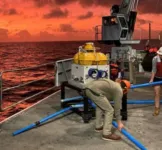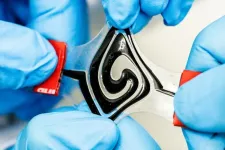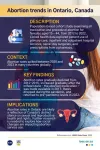(Press-News.org) Woods Hole, Mass. (April 11, 2025) - Being a geophysicist can sometimes feel like being a detective —uncovering clues, and then building a case based on the evidence.
In a new article published in Science Advances, a collaborative team led by the Woods Hole Oceanographic Institution (WHOI), presents a never-before-seen image of an oceanic transform fault from electromagnetic (EM) data collected at the Gofar fault in the eastern Pacific Ocean. The National Science Foundation funded work reveals unexpected brine deposits beneath the seafloor near the fault, which could change the way we conceptualize oceanic transform faults.
The Gofar fault operates much like the San Andreas, in that two tectonic plates slide sideways past each other. Unlike the San Andreas, large earthquakes on this fault have been strangely predictable, with large ruptures occurring every five to six years. That predictability has made Gofar an ideal place to study earthquake mechanisms, with a variety of data collected at the fault, including a number of small earthquakes measured on ocean bottom seismographs.
In contrast to seismic data, EM measurements tell researchers how well a material can conduct electricity. This is useful because one of the models for why Gofar behaves as it does is related to differences in the amounts of seawater present in the seafloor: fluids influence how faults stick, slide, and slip, causing earthquakes of various magnitudes. The salt in seawater makes it conduct electricity well, far better than the surrounding rocks, and so EM data provide clues as to where seawater or other fluids are hiding beneath the seafloor.
Using state of the art instruments, the study’s authors were able to create a snapshot of the electrical properties beneath the Gofar fault. They expected that one portion of the fault would be slightly more conductive than its surroundings based on prior models of such faults. Instead, the team was surprised to find that extremely conductive blobs reside beneath the seafloor on one side of the fault but not the other. To make matters more perplexing, other geophysical data from the area did not reveal similar anomalies.
“It was shocking to see such a stark contrast across the fault,” said Christine Chesley, a WHOI postdoc in Geology & Geophysics, and lead author of the study. “The conductivity structure defied all of our expectations based on what we thought we knew about oceanic transform faults.”
Oceanic transform faults have historically been thought of as simple, predictable features. They represent the least well-studied of the three major plate boundaries, which include divergent boundaries, like East Africa, where plates move apart forming new crust; and convergent boundaries, like the Himalayas, where two plates collide and recycle crust. However, recent findings like this necessitate a new framework for understanding oceanic transform faults.
“Whenever we go out and make these kinds of EM measurements, we see the seafloor through a different lens, and it almost always changes our views on the processes that shape the earth,” explained Rob Evans, Senior Scientist at WHOI in Geology & Geophysics and co-author of the study.
Determining why the conductive blobs appeared in the EM data, but did not present as other kinds of geophysical anomalies, required some deductive reasoning.
“We needed a self-consistent mechanism that could help explain why these conductive masses are existing under only one side of the fault and where seismic velocities seem unaffected,” Chesley explained. “Something with conductivities this high isn’t normally seen beneath the seafloor, except where magma is involved.”
Working with these puzzle pieces, the authors realized that the conductive blobs required salt—a lot of salt—to account for their high conductivity values. This suggested the anomalies represented brine accumulations.
“And in order to create brines, you need a source of heat,” added Chesley. “We think this heat source is magma near the transform fault.”
The authors hypothesized that some magma is present on the side of the fault where the conductive blobs of brine are found. This would be a remarkable shift in our understanding of transform faults, which have generally not been considered to host magmatic or hydrothermal activity.
“We have this amazing image of this particular section of the Gofar fault, but we haven’t yet been able to see how it connects to the adjacent mid-ocean ridge. We are hopeful that additional project funding will support additional research,” said Evans.
The National Science Foundation’s Division of Ocean Sciences supported this project.
The following institutions contributed to this research: University of Delaware; Boise State University; Scripps Institution of Oceanography, University of California San Diego; Western Washington University; University of Texas Austin; MIT-WHOI Joint Program in Oceanography/Applied Ocean Science and Engineering; University of Southern Maine; Columbia University; University of New Hampshire.
About Woods Hole Oceanographic Institution
Woods Hole Oceanographic Institution (WHOI) is a private, non-profit organization on Cape Cod, Massachusetts, dedicated to marine research, engineering, and higher education. Established in 1930, its mission is to understand the ocean and its interactions with the Earth as a whole, and to communicate an understanding of the ocean’s role in the changing global environment. WHOI’s pioneering discoveries stem from an ideal combination of science and engineering—one that has made it one of the most trusted and technically advanced leaders in fundamental and applied ocean research and exploration anywhere. WHOI is known for its multidisciplinary approach, superior ship operations, and unparalleled deep-sea robotics capabilities. We play a leading role in ocean observation and operate the most extensive suite of ocean data-gathering platforms in the world. Top scientists, engineers, and students collaborate on more than 800 concurrent projects worldwide—both above and below the waves—pushing the boundaries of knowledge to inform people and policies for a healthier planet. Learn more at whoi.edu.
END
Crustal brines at an oceanic transform fault
New research explores geological processes along plate boundaries
2025-04-11
ELSE PRESS RELEASES FROM THIS DATE:
The Journal of Nuclear Medicine Ahead-of-Print Tip Sheet: April 11, 2025
2025-04-11
Reston, VA (April 11, 2025)—New research has been published ahead-of-print by The Journal of Nuclear Medicine (JNM). JNM is published by the Society of Nuclear Medicine and Molecular Imaging, an international scientific and medical organization dedicated to advancing nuclear medicine, molecular imaging, and theranostics—precision medicine that allows diagnosis and treatment to be tailored to individual patients in order to achieve the best possible outcomes.
Summaries of the newly published research articles are provided below.
Tracing Prostate Cancer Beyond the Usual Path
Researchers uncovered ...
A fluid battery that can take any shape
2025-04-11
Using electrodes in a fluid form, researchers at Linköping University have developed a battery that can take any shape. This soft and conformable battery can be integrated into future technology in a completely new way. Their study has been published in the journal Science Advances.
“The texture is a bit like toothpaste. The material can, for instance, be used in a 3D printer to shape the battery as you please. This opens up for a new type of technology,” says Aiman Rahmanudin, assistant professor at Linköping University.
It is estimated that more than a trillion gadgets will be connected to the Internet in ten years’ time. In addition to traditional ...
Light that spirals like a nautilus shell
2025-04-11
Beams of light that can be guided into corkscrew-like shapes called optical vortices are used today in a range of applications. Pushing the limits of structured light, Harvard applied physicists in the John A. Paulson School of Engineering and Applied Sciences (SEAS) report a new type of optical vortex beam that not only twists as it travels but also changes in different parts at different rates to create unique patterns. The way the light behaves resembles spiral shapes common in nature.
The ...
Transforming doors into gateways to the virtual world: the future of mixed reality!
2025-04-11
Ikoma, Japan—People seeking to feel fully immersed in virtual environments will soon be able to experience a revolutionary approach to spatial computing that bridges the gap between real and digital worlds. A collaborative research team from NTT DOCOMO, Inc. and Nara Institute of Science and Technology (NAIST), Japan, has developed a novel mixed reality (MR) technology that transforms how users interact with virtual spaces by using everyday real-world doors as natural transition points.
Virtual reality (VR) and MR technologies have ...
AACR announces recipients of the 2025 AACR June L. Biedler Prize for Cancer Journalism
2025-04-11
PHILADELPHIA – The American Association for Cancer Research (AACR) is pleased to announce the recipients of the 2025 AACR June L. Biedler Prize for Cancer Journalism in the following categories:
Magazine
“Targeting Cancer, Sparing Patients”
By Jyoti S. Madhusoodanan (Photo), Scientific American
Newspaper
“Fighting stigma, fighting cancer: The rising threat of male breast cancer in Kenya”
By Pauline Ongaji Ogada (Photo), Nation
Online/Multimedia
“Farewell, my stomach”
By Teresa Firmino (Photo) and Joana Martins Gonçalves (Photo), Publico
“Women ...
Human-AI relationships pose ethical issues, psychologists say
2025-04-11
It’s becoming increasingly commonplace for people to develop intimate, long-term relationships with artificial intelligence (AI) technologies. At their extreme, people have “married” their AI companions in non-legally binding ceremonies, and at least two people have killed themselves following AI chatbot advice. In an opinion paper publishing April 11 in the Cell Press journal Trends in Cognitive Sciences, psychologists explore ethical issues associated with human-AI relationships, including their potential to disrupt human-human relationships and give harmful advice.
“The ...
Abortion rates remain relatively stable in Canada, while rates spike in UK, Europe, and US
2025-04-11
Vancouver, BC, April 11, 2025 – A new study finds that, unlike countries across the UK and Europe, abortion rates did not spike in Ontario, Canada from 2020-2022.
Following decades-long declines in nearly all high-income settings, abortion rate trends reversed between 2020 and 2022 in many countries. For example, 2022 and 2023 saw the highest abortion rates on record in Scotland, England, and Wales.
Researchers from the University of British Columbia and ICES found that, after accounting for changes in the abortion rate when the ...
Hundred-year storm tides will occur every few decades in Bangladesh, scientists report
2025-04-11
Tropical cyclones are hurricanes that brew over the tropical ocean and can travel over land, inundating coastal regions. The most extreme cyclones can generate devastating storm tides — seawater that is heightened by the tides and swells onto land, causing catastrophic flood events in coastal regions. A new study by MIT scientists finds that, as the planet warms, the recurrence of destructive storm tides will increase tenfold for one of the hardest-hit regions of the world.
In a study that will appear in One Earth, the scientists ...
Kidney function following COVID-19 in children and adolescents
2025-04-11
About The Study: In this large U.S. cohort study of children and adolescents, SARS-CoV-2 infection was associated with a higher risk of adverse postacute kidney outcomes, particularly among those with preexisting chronic kidney disease or acute kidney injury, suggesting the need for vigilant long-term monitoring.
Corresponding Author: To contact the corresponding author, Yong Chen, PhD, email ychen123@pennmedicine.upenn.edu.
To access the embargoed study: Visit our For The Media website ...
Risk factors for severe disease among children hospitalized with RSV
2025-04-11
About The Study: In this cohort study of children hospitalized with respiratory syncytial virus (RSV) in 2022 and 2023, severe RSV disease was more likely among those age 2 or older with pulmonary and neurologic, neuromuscular, or developmental conditions. For children younger than 2 years, age younger than 6 months and prematurity were the main risk factors. These findings support prevention strategies for all younger children, including premature infants, with potential benefit for children age 2 or older ...
LAST 30 PRESS RELEASES:
UT San Antonio physicists' groundbreaking discoveries open new paths to combating diseases
Operando X-ray tomography reveals silicon–electrolyte interface dynamics in all-solid-state batteries
Building better, building beautiful
Okayama University chemists pioneer light-driven macrolactone synthesis
Understanding how plants distribute iron to young leaves
Next-generation neuro: Studying the infant brain in motion
Before the party starts: Parental attitudes linked to college binge drinking
Ultrasound pinpoints vascular complications from cosmetic fillers
Human gene maps are biased towards European ancestries
Atomically-tailored single atom platforms hold promise for next-generation catalysis
USC study reveals hidden cellular layers in the brain’s memory center
SPHERE’s debris disk gallery: tell-tale signs of dust and small bodies in distant solar systems
Terrestrial biodiversity grows with tree cover in agricultural landscapes
Experts call for AED placement on every commercial aircraft to boost in-flight cardiac arrest survival rates from 6% to up to 70%
“Proton‑iodine” regulation of protonated polyaniline catalyst for high‑performance electrolytic Zn‑I2 batteries
Directional three‑dimensional macroporous carbon foams decorated with WC1−x nanoparticles derived from salting‑out protein assemblies for highly effective electromagnetic absorption
Tropical Australian study sets new standard for Indigenous-led research
Invitation to co-edit a special issue on intelligent additive manufacturing
Success in measuring nano droplets, a new breakthrough in hydrogen, semiconductor, and battery research
Shopping for two is stressful
Micro/nano‑reconfigurable robots for intelligent carbon management in confined‑space life‑support systems
Long-term antidepressant use surges in Australia, sparking warnings of overprescribing
To bop or to sway? The music will tell you
Neural network helps detect gunshots from illegal rainforest poaching
New evidence questions the benefit of calcium supplements in pregnancy for preventing pre-eclampsia
A molecular ‘reset button’ for reading the brain through a blood test
Why do some lung transplant patients face higher rejection risk?
New study offers a glimpse into 230,000 years of climate and landscape shifts in the Southwest
Gender-specific supportive environment key to cutting female athletes’ injury risks
Overreliance on AI risks eroding new and future doctors’ critical thinking while reinforcing existing bias
[Press-News.org] Crustal brines at an oceanic transform faultNew research explores geological processes along plate boundaries






